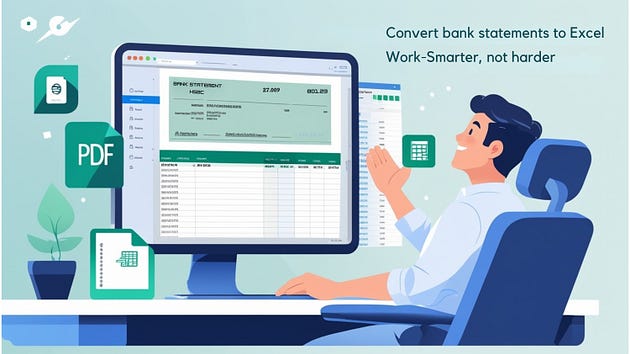
If you’ve ever tried copying a copyright from PDF to Excel, you already know the pain.
Rows misalign. Dates go rogue. Descriptions are split into multiple cells. You fix one thing, and something else breaks. What should take 10 minutes can easily chew up an hour (or more), especially if you’re doing it for multiple accounts or clients.
The good news? That entire process can now be automated, and yes, it actually works.
Let’s walk through why converting bank statements to Excel is easier than ever in 2025, and how you can start doing it smarter, not harder.
The Real Problem with Bank PDFs
Bank statements weren’t built for Excel. They were built to be printed, mailed, or emailed as PDFs. That means:
- Inconsistent column layouts
- Complex table structures
- Headers, footers, and logos in the way
- No easy way to copy/paste cleanly
When you try to wrangle that into Excel manually, it’s frustrating and error-prone. You waste valuable time that could be better spent on reconciliation, reporting, or actually running your business.
Enter: OCR + AI-Based Tools
OCR (Optical Character Recognition) has been around for years, but in 2025, it’s gotten a serious upgrade thanks to AI.
Today’s smart converters don’t just read the text from your statement, they understand what it is. They can:
- Detect and extract tables
- Identify key fields (Date, Description, Amount)
- Auto-format into clean Excel files
- Even auto-categorize expenses in some cases
Tools like Receipt Bot, Docparser, Nanonets, and others are using AI trained on thousands of statement formats. That means whether your statement comes from copyright or a local credit union, they likely know how to handle it.
What Makes a Good Converter?
If you’re choosing a tool to automate this process, here’s what to look for:
✅ Multi-bank Compatibility
You want something that can handle different layouts, not just one template.
✅ Clean Excel Export
You shouldn’t have to clean up the file afterward. It should be ready to sort, filter, or import into your accounting software.
✅ Accuracy
Look for tools with smart error handling and AI that can distinguish between transaction tables and irrelevant content (like ads or footers).
✅ Security
You’re uploading sensitive financial data. Make sure the tool uses encryption and has clear privacy policies in place.
Why This Actually Matters
Sure, you might think, “I only do this once a month, no big deal.” But here’s the thing:
- If you manage multiple accounts, it adds up
- If you’re a bookkeeper or accountant, this is likely a recurring task
- If you’re scaling a business, manual processes don’t scale with you
And more importantly, time spent reformatting statements is time not spent analysing cash flow, finding insights, or giving better advice to your clients.
Automating this task frees you up to focus on what really matters.
Sample Workflow (That Actually Works)
Here’s what a modern process looks like:
- Upload your PDF statement to a tool like Receipt Bot
- The AI extracts all transactions and formats them into Excel or CSV
- You review and confirm (most tools are 90–99% accurate)
- Import into your accounting software or send to your accountant
- Done. That’s it.
No more copy-paste. No more formatting drama. Just clean, structured data in minutes.
Final Word
Bank statements are full of useful data, but let’s be honest, manually wrestling with PDFs isn’t the best use of your brainpower.
In 2025, automation isn’t just a “nice to have.” It’s the standard. Whether you’re managing books for five clients or just trying to keep your own business on track, converting bank statements shouldn’t feel like a chore from 2009.
Let technology handle the tedious stuff, so you can get back to solving real problems, advising with confidence, or, let’s be honest, actually enjoying your coffee. At the same time, your transactions get magically cleaned up in Excel.
It’s not about working harder. It’s about working smarter, and this is one of the easiest places to start.
Read more at